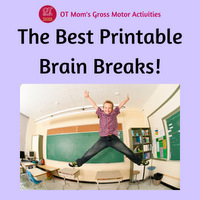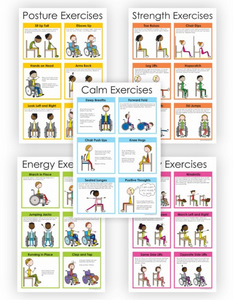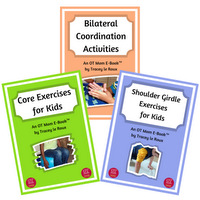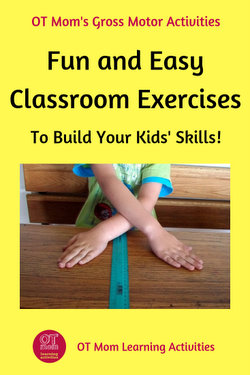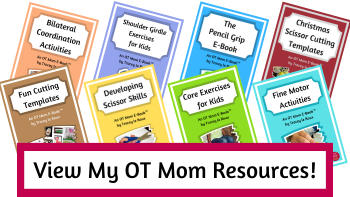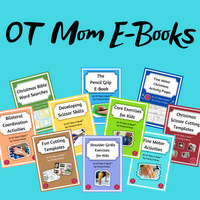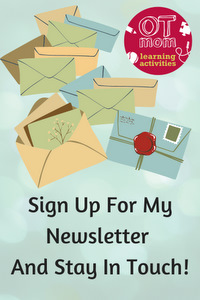- Home Page
- Gross Motor Activities
- Gross Motor Exercises for the Classroom
Gross Motor Exercises
For The Classroom
Did you know how helpful gross motor exercises can be when you use them during school time?
There have been quite a few research papers and media articles on how exercise can affect a child's performance in the classroom. Generally, most of these articles show that kids concentrate better after some form of physical activity, and there have also been reported improvements in math, language and memory. I have linked to some of the research at the bottom of this page.
Savvy teachers have been incorporating general gross motor exercises such as running on the spot and jumping jacks, or even just stretching exercises as quick breaks between lessons to boost kids’ concentration.
However,
I would like to go one step further and encourage teachers to
specifically include gross motor activities that use vestibular and bilateral
movements. These are the two types of movement
that have been associated with improved academic performance.
The next two sections will explain a bit more about each kind of movement and give you some inspiration for simple classroom gross motor activities.
You can use these ideas to get the kids moving between lessons, or for indoor recess on a rainy day!

Vestibular Exercises
A series of articles in the Washington Post highlighted the
experience and recommendations of an occupational therapist who sat in
on a regular classroom.
She pointed out that merely taking a
quick break to run on the spot or stretch is beneficial to a point, but
the best exercises are the ones that give vestibular stimulation
– in other words they stimulate the hair cells of the vestibular system
in the inner ear.
It can be hard to understand, but the vestibular system has an effect on other areas of a child's development, such as coordination and balance skills, calming down, becoming more organized and becoming more focused. You could read one of the sensory processing books that I have reviewed to help understand this in more depth.
So we don’t just want the body to jiggle and stretch a bit, we want the head to move! We need to give kids gross motor exercises that offer vestibular stimulation!
Important! Some children are over-sensitive to vestibular stimulation, even during simple activities like these. If a child becomes fearful, nauseous, pale or sweaty during these activities, please stop immediately and consult your health professional!
1) Picking Up... and Up... and Up!
Have the kids place 10 pencils (or other stationery) on the floor, and then have them bend to pick up one item at a time and then place it on their desks again.
The repetitive up and down bending moves the head upside down and then right-side-up again and gives some good vestibular stimulation.
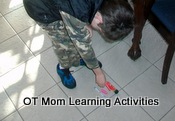 Picking Up Stationery
Picking Up StationeryGet the most out of the activity by having the kids bend and rise while you clap a rhythm.
2) Heads, Shoulders, Knees and Toes!
Do the “heads, shoulders, knees and toes” song – another exercise that gets kids’ heads going up and down as they carry out the actions of the song.
This song is done on the spot, so it is great for classes with limited space!
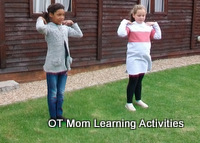 Shoulders!
Shoulders!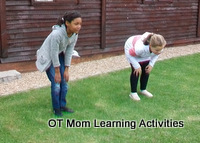 Knees!
Knees!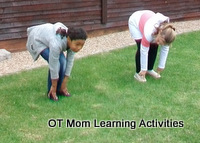 And Toes!
And Toes!However, do encourage your children to tilt their heads down when they go down, as the child on the right is doing. This gives the most vestibular input. The child on the left is looking up, and therefore not getting as much vestibular stimulation as she could.
3) Recess Activities
You can also encourage your kids to swing, spin on roundabouts, roll down hills and twirl during recess and gym class for additional vestibular stimulation.
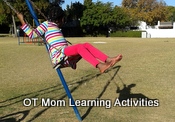 Swinging
Swinging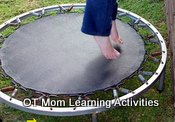 Jumping
Jumping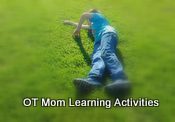 Rolling
RollingBilateral Classroom Exercises
Activities that involve bilateral coordination have also been linked to improved academic performance. Some researchers suggest that coordination exercises facilitate the parts of the brain that are needed for thinking skills and for paying attention.
Kids who took part in highly focused bilateral activities, even for 5 minutes, showed improved attention, concentration and better focus on the task at hand, compared to students who did not take part. Some studies have also linked math, writing and reading abilities to bilateral coordination skills.
So it is definitely worth taking a quick 5-minute break between lessons to do some gross motor exercises that move both sides of the body in a coordinated way.
Get the most out of the activities by clapping a rhythm that kids need to move to (in order to improve their timing and sequencing skills) or add some skip counting to work on math while they move!
1) Jumping Jacks
Jumping jacks (also called star jumps) can be done on the spot, right next to or behind the desk. Watch out for kids who can only move their arms or legs, and not both; and for kids who struggle to do more than a couple of jumps at a time. These kids may need to see an occupational therapist for an evaluation if they are not able to do what their peers do.
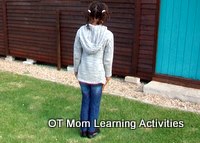 Starting Jumping Jacks
Starting Jumping Jacks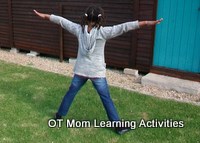 Jumping Jacks
Jumping Jacks2) Marching On The Spot
Have the kids march on the spot next to their desks, swinging their arms in time with their legs.
- Sing a marching song or clap to keep the beat for them.
- You can make this more interesting by doing high marches (lifting knees up as high as you can), quiet marches, and stomping marches.
- You can also bring in an imaginary focus and march like different kinds of animals!
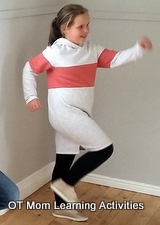 March on the spot
March on the spot3) Keep the Beat
Beat out a simple rhythm with your hands, and have the children copy your beat rhythm with their hands on their desks or on the floor.You can beat both hands on the desk together for symmetrical bilateral movements, or alternate hands.
You can bring some clapping or crossing over into the beat as well.
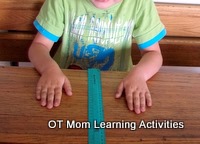 Starting Position
Starting Position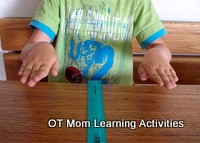 Symmetrical Beats
Symmetrical Beats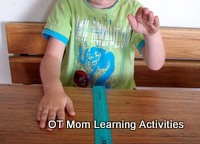 Alternate Beats
Alternate BeatsGross Motor Exercises Printables
1) Get Your OT Mom Free Printable!
If you liked the exercises on this page, you can get all of them and a
bunch more in this free printable!
6 pages of quick and easy gross motor exercises that kids can do while sitting at their desk, standing behind their desk, or on the mat. You will find all the exercises on this page in the download, as well as a few more from throughout my website.
Fill in this form to access your freebie right away! You also have the option of signing up for my newsletter through this form!
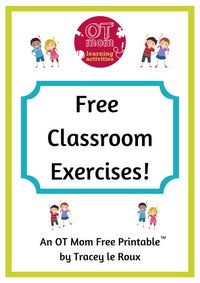 Free Download!
Free Download!2) Try some Brain Breaks
Brain breaks are just the most fun way to take a classroom exercise break! I use them in my homeschool classroom as well as anywhere I have a bunch of kids together for any period of time.
They make terrific indoor recess activities, as well.
I have reviewed my favorite brain breaks - there are a variety of digital, poster or printable brain breaks to suit any classroom!
Simply print and cut out the cards, and store them in a handy container so you or the kids can pull one out whenever a "brain break" is needed. You can make your own, of course, but these are really cheap, and a great time saver!
3) Printable Chair Exercises For School
My talented therapist friend over at Your Therapy Source has made it easy for kids to do exercises in their chairs - whether in regular chairs or in wheelchairs!
You can order the 5 color posters in printed format#Ad (PRIME delivery in the USA) or you can get a digital bundle#Ad of color posters, full page versions, and exercise cards - in black and white or color.
4) More OT Mom Resources
You can also check out my gross motor e-books if you want access to lots of gross motor activities (more than you will find on my site) in an affordable, accessible, printable download!
I hope you found this article helpful!
Thanks for visiting!
- Home Page
- Gross Motor Activities
- Gross Motor Exercises for the Classroom
Share this page to help others!
References
All links open in a new tab/window.
- Buchele Harris, H.; Cortina, K.; Templin, T.; Colabianchi, N. and Chen, W. (2018). Impact of Coordinated-Bilateral Physical Activities on Attention and Concentration in School-Aged Children. BioMed Research International. 2018. 1-7. https://dx.doi.org/10.1155/2018/2539748
- Lane, S.; Mailloux, Z.; Schoen, S.; Bundy, A.; May-Benson, T.; Parham, L.; Roley, S. and Schaaf, R. (2019). Neural Foundations of Ayres Sensory Integration®. Brain Sciences. 9. 153. https://dx.doi.org/10.3390/brainsci9070153.
- Pacheco, S.; Gabbard, C.; Ries, L. and Bobbio, T. (2016). Relationship Between Interlimb Coordination
and Academic Performance In Elementary School Children. Pediatrics International.
58. https://dx.doi.org/10.1111/ped.12972
- Wong, T.P.S.; Leung, E.Y.W.; Poon, C.Y.C.; Leung, C.Y.F. and Lau, B.P.H. (2013). Balance performance in children with unilateral and bilateral severe-to-profound-grade hearing impairment. Hong Kong Physiotherapy Journal. 31. 81–87. https://dx.doi.org/10.1016/j.hkpj.2013.07.001
Didn't find what you were looking for? Try a search of my site!
